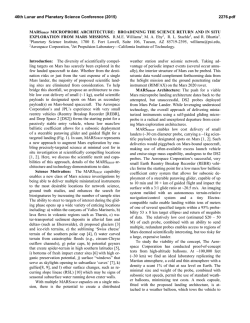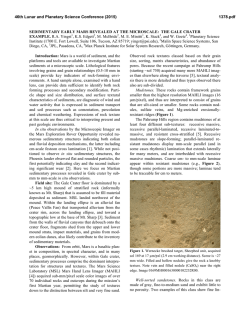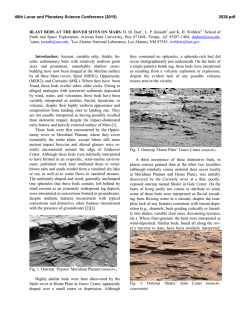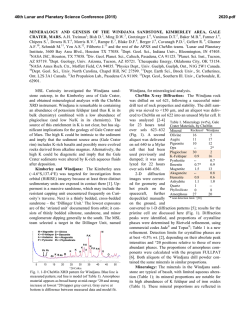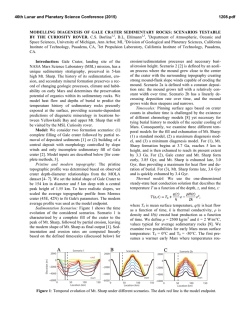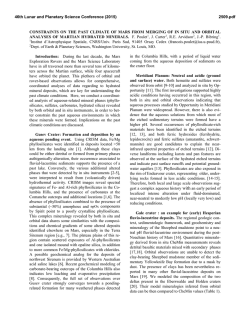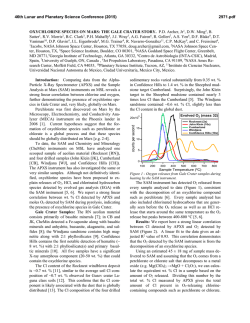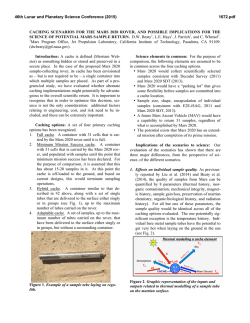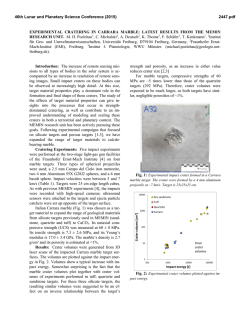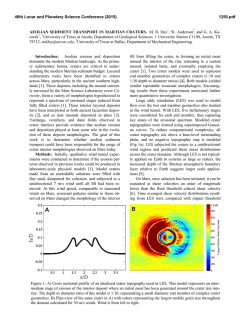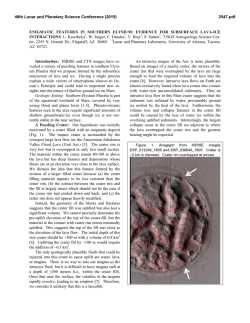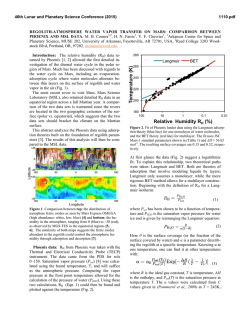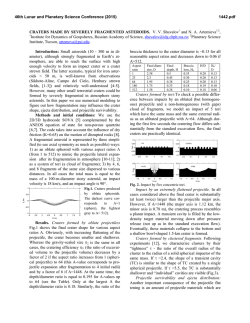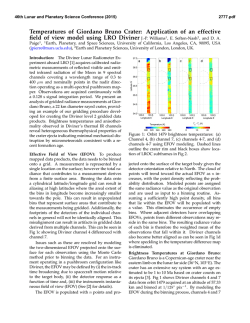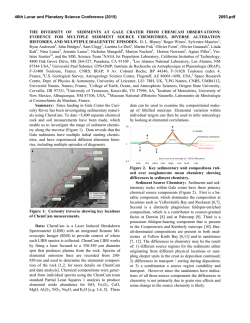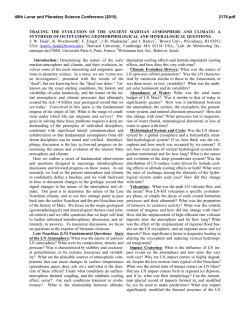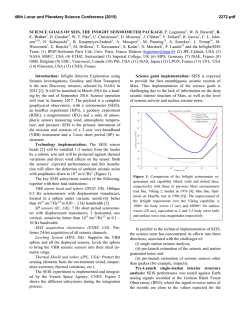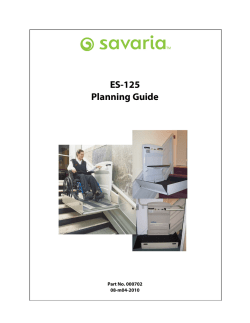
2791
46th Lunar and Planetary Science Conference (2015) 2791.pdf ASSESSING GALE CRATER AS A POTENTIAL HUMAN MISSION LANDING SITE ON MARS F. J. Calef III1 B. Clark2, W. Goetz3, J. Lasue4, 5J. Martin-Torres, and 6M. Zorzano Mier, 1Jet Propulsion LaboratoryCaltech, [email protected], 2Space Science Institute, [email protected], 3Max Planck Institute for Solar System Research, [email protected], 4L’Irap Soutient Sciences En Marche, [email protected], 5Instituto Andaluz de Ciencias de la Tierra (CSIC-UGR), [email protected], 6Centro de Astrobiología (INTA-CSIC), [email protected]. Introduction: Mars is the “horizon goal” for huEDL: Like all missions, Mars’ elevation limits man space flight [1]. Towards that endeavor, one must landing sites to those with a fairly deep atmospheric consider several factors in regards to choosing a landwell to assist in aerobraking and parachute deceleration ing site suitable for a human-rated mission including: in preparation for landing. Previous missions have tarentry, descent, and landing (EDL) characteristics, scigeted areas below the 0 km Martian elevation line [3]. entific diversity, and possible insitu resources [2]. SeThermal requirements have kept landing sites with ~30 lecting any one place is a careful balance of reducing degrees of the equator, except for the short-lived Phoerisks and increasing scientific return for the mission. nix mission (by design). Most proposed landing sites “Go where you know”: There are tens of promeet these criteria, as well as basic rock abundance, posed landing sites for robotic missions with varying relief, dust, and thermal inertia requirements all likely scientific interest, as well as the handful of locations suitable for a human mission as well. currently visited by successfully landed spacecraft. For Insitu resources: While there are many technolothe former, sites such as Eberswalde delta, Holden gies yet to be devised for resource extraction, we can crater, and Mawrth Vallis has received extensive orlook at the one resource that provides breathable air, bital coverage and analysis during the MSL landing sustenance, and fuel: water. Besides the poles, watersite selection workshop and are well characterized. In ice deposits have been found near the surface down to addition, ‘runner up’ candidates for that mission are latitudes as low as ~43 degrees [4]. If a mission wanted now on the list for evaluation for the Mars2020 rover, to drill to potential subsurface ice-water reservoirs, e.g. Jezero Crater or Nili Fossae, and contain equal being closer to the poles would be advantageous. (though not fully processed) orbital data for reference However, many landing sites have water bound in [3]. For legacy and current missions to Mars, three are there constituent rocks (e.g. clays) to serve as a ‘minlanders, and one lander/ rover, with limited visible ing’ resource. Results from the CHEMCAM instruareal extent: Viking 1 Viking 2, Phoenix, and Pathment aboard Curiosity have also reported higher water finder/Sojourner. The remaining rover missions, MER abundance in soils [5]. Dune sands/ripples/soils, where Spirit, MER Opportunity, and MSL Curiosity offer the available, may provide an additional resource for water most ground truth over several to tens of kilometers extraction technologies. both in and outside their nominal landing ellipses. Why Gale crater: The following is a breakdown While the HiRISE instrument provides unprecedented of reasons Gale crater makes an excellent landing site detail of Mars’ surface to current and future missions, for the first human mission to Mars. EDL: Gale crater is one of the lowest elevation the insitu observations of rock density, soil mechanics, landing sites at ~4.5 km MOLA elevation, well below temperature fluctuations, dust opacity, radiation (via Meridiani Planum (~-1.4 km) and Gusev Crater (-1.9 Curiosity), traversability, not to mention insitu science, km) [3]. This increased atmospheric density will deare not directly measureable or resolvable by orbital crease requirements for landing from increased velociassets. While we can certainly make well-educated and ty reduction with parachutes or other methods like higher-order assessments of landing sites, revisiting low-density supersonic deceleration. Dynamic entry anywhere we’ve gone before can only reduce risk by data and a well-understood atmospheric profile, includremoving uncertainty or shrinking errors bars in landing additional seasonal data (temperature, pressure, ing site analysis. Insitu data decreases risk compared to wind speed) from the Rover Environmental Monitorother potential landing sites that have never been visiting Station [REMS] package onboard Curiosity for at ed because of this ability to remove the unknown at the least a Martian year, adds to reducing uncertainty dursurface; albeit we’ve been very successful over the ing any landing. These atmospheric measurements, as past two decades with landed missions. However, a a whole, are unique to this locale. human-rated mission will likely require reducing risk Radiation: The thick ‘air’ also provides more radiby an order of magnitude, thereby requiring an order of ation protection than other sites. Back-of-the-envelope magnitude better data than we currently have; only extrapolations from [6] indicate ~25-32 gm/cm2 shieldinsitu data provides this level of certainty. From a fiing at 90-degree elevation (i.e. directly overhead); 6-8 nancial perspective, insitu data is ‘priceless’ for a hugm/cm2 more shielding than Gusev or Meridiani. man-rated mission, not replicable for other sites. 46th Lunar and Planetary Science Conference (2015) While the additional atmospheric shielding yields only an incremental improvement in protection from Galactic Cosmic Radiation (GCR) and solar proton events compared to other landing sites, more is better for any long-term mission. There is likely some additional shielding to be gain from the crater walls, though this doesn’t mitigate the majority of overhead radiation. More importantly, the RAD instrument onboard Curiosity initial results from ~300 sols [7] indicates 0.64 +0.12 millisieverts/day or ~1.01 Sv for a Mars mission at this location. Hardware can now be tuned with insitu measurements to meet the radiation hazard at this location. Terrain: In terms of terrain hazards, ~10 km of engineering camera (NAVCAM and HAZCAM) and mobility data provide an unprecedented level of terrain information, excluding the Opportunity rover (>40 km). While Meridiani is likely the smoothest and safest of any landing site [3], Gale is rated as safe as other landing sites with terrain hazards sampled and well understood throughout its traverse to Aeolis Mons. Scientific Diversity: Going with ‘what we know’, the Peace Vallis delta deposits [8], confirmed habitable environments [9], evidence of a lake [9], insitu methane observations [10], and existence of indigenous Martian carbon both ancient and active [11], not to mention the yet fully explored 5 km sedimentary stack of Mt. Sharp (Aeolis Mons) is a scientific cornucopia for an human mission to expand upon and explore. Gale crater is also one of, if not the, only site with access to both northern plains and southern highland material within a relatively short distance (~20 km). While other sites offer the possibilities of meandering rivers (Eberswalde), extensive clay deposits (Mawrth Vallis), sabkha/lake/sea deposits (Meridiani), and carbonates (Gusev), we know right now that Gale has many of these elements, if not more variety, than other sites can definitively offer. Insitu Water Resources: There is little chance of near-surface water-ice for resource utilization, but water bound in minerals and loose grains could serve as a water source. Some ‘easy’ water may come extracting adsorbed atmospheric water in ripple and dune sediments [5] and estimated 3-6 weight% in amorphous sediments at Rocknest [12]. Gale crater’s depth might assist in locating a deep aquifer source through drilling. Groundwater inventories could be within a few hundred meters depth from the inner depths of Gale, assuming an initial global water layer between 10100m [13]. Lack of readily available water in any form is a problem for the vast majority of proposed landing sites near the equator; however Gale crater provides a clear advantage of depth for accessing groundwater aquifers and a known quantity of adsorbed and ‘miner- 2791.pdf alized’ water that can be planned for based on insitu measurements. Reference Mission: Reference design missions have been generated for the human exploration for Mars, a recent one being Mars design reference architecture (DRA) 5.0 [2]. Though Gale crater can easily meet all the science and engineering goals I-V in DRA 5.0, two mission types were proposed: “short-stay” with 30-90 days on the surface (500-650 days total) and “long-stay” with 500+ days on Mars (~900 days total). “Short-stay” missions were ruled out partially because of insufficient time for assessing and collecting diverse samples. Gale crater offers crustal material within ~20 km at the rim, Aeolis Mons (Mt. Sharp) clay to sulfate transition within ~15 km, primary alluvial fan material <5 km and fluvially derived conglomerates and clays, some lacustrine, upon landing in many areas of the current MSL ellipse. The Isidis/Syrtis reference landing site in DRA 5.0 had most scientific features well beyond the safe ‘walkback’ distance of ~20 km from a centrally located habitat. Many known scientific outcrops at Gale crater are well within this distance if the human habitat where placed within the current MSL landing ellipse. For a human first mission to Mars, distance to outcrops would be close, safe, and pre-characterized sufficiently by Curiosity to allow short or long-stay missions. Conclusion: Gale crater is a scientifically fascinating site on Mars with abundant existing orbital and ground data for assessing a future human mission to Mars. The deep atmosphere provides substantial EDL margin unique to this location. A well-characterized radiation environment provides hallmarks for designing habitats and assessing daily exposure limits for extravehicular activities. The MSL science team has already shown Gale crater to harbor ancient habitable environments and abundant liquid water in the past. A human mission to this location could be done safely and with assurance to what we’d find on arrival and the strong potential for future discoveries. References: [1] Pathways to Exploration, ISBN: 978-0-309-30507-5, 2014. [2] Human Exploration of Mars DRA v5.0, NASA-SP-2009-566, 2009. [3] Golombek et al., Space Sci Rev, 2012. [4] Byrne et al., Science, 2009. [5] Meslin et al., Science, 2013. [6] Simonsen & Nealy, NASA Tech. Paper 3300, 1993. [7] Hassler et al., Science, 2014. [8] Palucis et al., JGR, 2013. [9] Grotzinger et al., Science, 2013. [10] Webster et al., Science, 2014. [11] NASA/JPL press release,http://mars.nasa.gov/msl/news/whatsnew/index.c fm?FuseAction=ShowNews&NewsID=1767, 2014. [12] Leshin et al., Science, 2013. [13] Clifford, JGR. 1993.
© Copyright 2026
